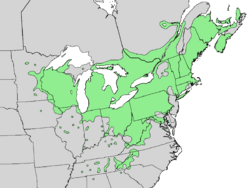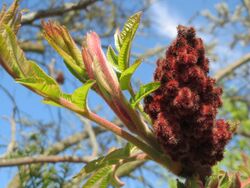Biology:Rhus typhina
| Rhus typhina | |
|---|---|

| |
| Scientific classification | |
| Kingdom: | Plantae |
| Clade: | Tracheophytes |
| Clade: | Angiosperms |
| Clade: | Eudicots |
| Clade: | Rosids |
| Order: | Sapindales |
| Family: | Anacardiaceae |
| Genus: | Rhus |
| Species: | R. typhina
|
| Binomial name | |
| Rhus typhina | |

| |
| Synonyms | |
|
Rhus hirta | |
Rhus typhina, the staghorn sumac,[4] is a species of flowering plant in the family Anacardiaceae, native to eastern North America. It is primarily found in southeastern Canada, the northeastern and midwestern United States, and the Appalachian Mountains,[5] but it is widely cultivated as an ornamental throughout the temperate world. It is an invasive species in some parts of the world.
Etymology
The Latin specific epithet typhina is explained in Carl Linnaeus and Ericus Torner's description of the plant with the phrase "Ramis hirtis uti typhi cervini", meaning "the branches are rough like antlers in velvet".[6]
Description
Rhus typhina is a dioecious, deciduous shrub or small tree growing up to 5 m (16 ft) tall by 6 m (20 ft) broad. It has alternate, pinnately compound leaves 25–55 cm (10–22 in) long, each with 9–31 serrate leaflets 6–11 cm (2 1⁄4–4 1⁄4 in) long.[7] Leaf petioles and stems are densely covered in rust-colored hairs. The velvety texture and the forking pattern of the branches, reminiscent of antlers, have led to the common name "stag's horn sumac".[8] Staghorn sumac grows as female or male clones.[9]
Small, greenish-white through yellowish flowers occur in dense terminal panicles, and small, green through reddish drupes occur in dense infructescences.[7] Flowers occur from May through July and fruit ripens from June through September in this species’ native range.[10] Infructescences are 10–20 cm (4–8 in) long and 4–6 cm (1 1⁄2–2 1⁄4 in) broad at their bases. Fall foliage is brilliant shades of red, orange and yellow.[8] Fruit can remain on plants from late summer through spring. It is eaten by many birds in winter.[11]
Staghorn sumac spreads by seeds and rhizomes and forms clones often with the older shoots in the center and younger shoots around central older ones.[7] Large clones can grow from ortets in several years.
Within Anacardiaceae, staghorn sumac is not closely related to poison sumac (Toxicodendron vernix), even though they share the name "sumac".
In late summer some shoots have galls on leaf undersides, caused by the sumac leaf gall aphid, Melaphis rhois. The galls are not markedly harmful to the tree.
Cultivation
Staghorn sumac is an ornamental plant which provides interest throughout the year; though its vigorous, suckering habit makes it unsuitable for smaller gardens. It can grow under a wide array of conditions, but is most often found in dry and poor soil on which other plants cannot survive.[7] Some landscapers remove all but the top branches to create a "crown" effect in order to resemble a small palm tree. Numerous cultivars have been developed for garden use, of which the following have gained the Royal Horticultural Society’s Award of Garden Merit:[12]
Uses
The fruit of sumacs are edible.[15] They can be soaked and washed in cold water, strained, sweetened and made into a pink "lemonade" sometimes called "Indian lemonade".[16] The drink extract can also be used to make jelly. The shoots can be peeled and eaten raw.[17][15] The fruit was found to have certain natural antioxidant and antimicrobial properties.[18]
All parts of the staghorn sumac, except the roots, can be used as both a natural dye and as a mordant. The plant is rich in tannins and can be added to other dye baths to improve light fastness. The leaves may be harvested in the summer and the bark all year round.[19]
References
- ↑ Stritch, L. (2018). "Rhus typhina". IUCN Red List of Threatened Species 2018: e.T61984086A61984088. doi:10.2305/IUCN.UK.2018-1.RLTS.T61984086A61984088.en. https://www.iucnredlist.org/species/61984086/61984088. Retrieved 19 November 2021.
- ↑ "NatureServe Explorer 2.0". https://explorer.natureserve.org/Taxon/ELEMENT_GLOBAL.2.135152/Rhus_typhina.
- ↑ taxonomy. "Taxonomy browser (Rhus typhina)". https://www.ncbi.nlm.nih.gov/Taxonomy/Browser/wwwtax.cgi?mode=Info&id=255348&lvl=3&keep=1&srchmode=1&unlock&mod=1&log_op=modifier_toggle.
- ↑ "Rhus typhina". Natural Resources Conservation Service PLANTS Database. USDA. https://plants.usda.gov/core/profile?symbol=RHTY.
- ↑ "Rhus typhina Range Map". United States Geological Survey. http://esp.cr.usgs.gov/data/atlas/little/rhustyph.pdf.
- ↑ Linnaeus, Carl (1756). Centuria II plantarum. 2. exc. L.M. Höjer. p. 14. https://www.biodiversitylibrary.org/page/36017979.
- ↑ 7.0 7.1 7.2 7.3 Uva, Richard H.; Neal, Joseph C.; Ditomaso, Joseph M. (1997). Weeds of The Northeast. Ithaca, NY: Cornell University Press. pp. 326–327. ISBN 0-8014-3391-6.
- ↑ 8.0 8.1 RHS A-Z encyclopedia of garden plants. United Kingdom: Dorling Kindersley. 2008. pp. 1136. ISBN 978-1405332965.
- ↑ Sullivan, Janet (1994), Rhus typhina, US Department of Agriculture (USDA), Forest Service (USFS), Rocky Mountain Research Station, Fire Sciences Laboratory, https://www.fs.fed.us/database/feis/plants/tree/rhutyp/all.html
- ↑ "Rhus". USDA Forest Service. http://www.nsl.fs.fed.us/wpsm/Rhus.pdf.
- ↑ Niering, William A.; Olmstead, Nancy C. (1985). The Audubon Society Field Guide to North American Wildflowers, Eastern Region. Knopf. p. 327. ISBN 0-394-50432-1.
- ↑ "AGM Plants - Ornamental". Royal Horticultural Society. July 2017. p. 87. https://www.rhs.org.uk/plants/pdfs/agm-lists/agm-ornamentals.pdf.
- ↑ "RHS Plantfinder - Rhus typhina 'Dissecta'". https://www.rhs.org.uk/Plants/105810/i-Rhus-typhina-i-Dissecta/Details.
- ↑ "Rhus typhina Radiance = 'Sinrus'". RHS. https://www.rhs.org.uk/Plants/263253/Rhus-typhina-Radiance-Sinrus/Details.
- ↑ 15.0 15.1 Elias, Thomas S.; Dykeman, Peter A. (2009). Edible Wild Plants: A North American Field Guide to Over 200 Natural Foods. New York: Sterling. pp. 250. ISBN 978-1-4027-6715-9. OCLC 244766414. https://www.worldcat.org/oclc/244766414.
- ↑ Peterson, Lee Allen (1977). Edible Wild Plants. New York: Houghton Mifflin. p. 186. ISBN 0-395-20445-3.
- ↑ Thayer, S. (2006). The Forager's Harvest. Forager's Harvest.
- ↑ Kossah, Rima; Zhang, Hao; Chen, Wei (2011-01-01). "Antimicrobial and antioxidant activities of Chinese sumac (Rhus typhina L.) fruit extract". Food Control 22 (1): 128–132. doi:10.1016/j.foodcont.2010.06.002. ISSN 0956-7135. https://www.sciencedirect.com/science/article/pii/S0956713510001684.
- ↑ Dean, Jenny (1999). Wild Color: The Complete Guide to Making and Using Natural Dyes. New York: Watson-Guptill. p. 123. ISBN 9780823057276. https://archive.org/details/wildcolor00dean.
External links
- {{citation
| mode = cs1 | title = Rhus typhina | work = Germplasm Resources Information Network (GRIN) | url = | publisher = [[Organization:Agricultural Research ServAgricultural Research Service (ARS), United States Department of Agriculture (USDA) | access-date = }}
- Bioimages: Rhus typhina.
- Brian Johnston. A Close-up View of the Staghorn Sumac (Rhus typhina). Microscopy—UK.
Wikidata ☰ Q148986 entry
 |




